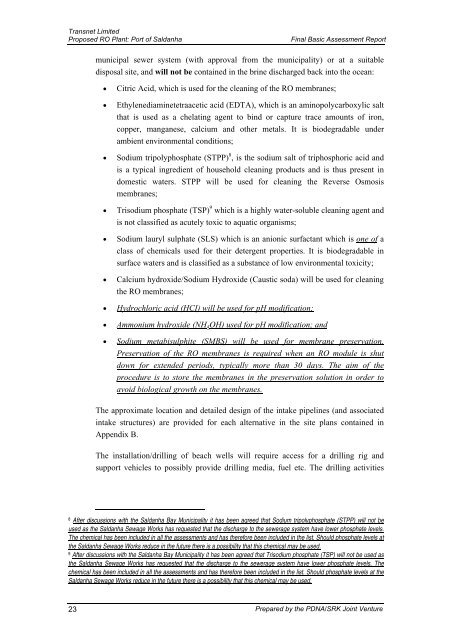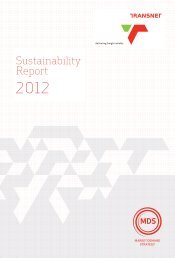Basic Assessment Report - Transnet
Basic Assessment Report - Transnet
Basic Assessment Report - Transnet
You also want an ePaper? Increase the reach of your titles
YUMPU automatically turns print PDFs into web optimized ePapers that Google loves.
<strong>Transnet</strong> LimitedProposed RO Plant: Port of SaldanhaFinal <strong>Basic</strong> <strong>Assessment</strong> <strong>Report</strong>municipal sewer system (with approval from the municipality) or at a suitabledisposal site, and will not be contained in the brine discharged back into the ocean:• Citric Acid, which is used for the cleaning of the RO membranes;• Ethylenediaminetetraacetic acid (EDTA), which is an aminopolycarboxylic saltthat is used as a chelating agent to bind or capture trace amounts of iron,copper, manganese, calcium and other metals. It is biodegradable underambient environmental conditions;• Sodium tripolyphosphate (STPP) 8 , is the sodium salt of triphosphoric acid andis a typical ingredient of household cleaning products and is thus present indomestic waters. STPP will be used for cleaning the Reverse Osmosismembranes;• Trisodium phosphate (TSP) 9 which is a highly water-soluble cleaning agent andis not classified as acutely toxic to aquatic organisms;• Sodium lauryl sulphate (SLS) which is an anionic surfactant which is one of aclass of chemicals used for their detergent properties. It is biodegradable insurface waters and is classified as a substance of low environmental toxicity;• Calcium hydroxide/Sodium Hydroxide (Caustic soda) will be used for cleaningthe RO membranes;• Hydrochloric acid (HCI) will be used for pH modification;• Ammonium hydroxide (NH 4 OH) used for pH modification; and• Sodium metabisulphite (SMBS) will be used for membrane preservation.Preservation of the RO membranes is required when an RO module is shutdown for extended periods, typically more than 30 days. The aim of theprocedure is to store the membranes in the preservation solution in order toavoid biological growth on the membranes.The approximate location and detailed design of the intake pipelines (and associatedintake structures) are provided for each alternative in the site plans contained inAppendix B.The installation/drilling of beach wells will require access for a drilling rig andsupport vehicles to possibly provide drilling media, fuel etc. The drilling activities8After discussions with the Saldanha Bay Municipality it has been agreed that Sodium tripolyphosphate (STPP) will not beused as the Saldanha Sewage Works has requested that the discharge to the sewerage system have lower phosphate levels.The chemical has been included in all the assessments and has therefore been included in the list. Should phosphate levels atthe Saldanha Sewage Works reduce in the future there is a possibility that this chemical may be used.9After discussions with the Saldanha Bay Municipality it has been agreed that Trisodium phosphate (TSP) will not be used asthe Saldanha Sewage Works has requested that the discharge to the sewerage system have lower phosphate levels. Thechemical has been included in all the assessments and has therefore been included in the list. Should phosphate levels at theSaldanha Sewage Works reduce in the future there is a possibility that this chemical may be used.23Prepared by the PDNA/SRK Joint Venture
















